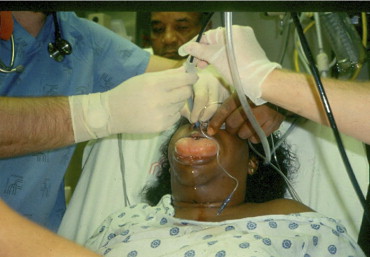An idiosyncratic reaction to commonly prescribed angiotensin-converting enzyme (ACE) inhibitors may require tracheal intubation or a surgical airway for impending respiratory compromise due to massive tongue swelling ( Figure 1 ) . This is not an immunoglobulin E–mediated allergic reaction, and treatment with diphenhydramine, methylprednisolone, and epinephrine will not reverse the pathology. There are no effective pharmacologic interventions to reverse or slow this form of angioedema, although the use of fresh frozen plasma has been suggested. Currently, the effectiveness of the kallikrein inhibitor ecallantide is under study. Definitive intervention is securing the airway, admittedly a very formidable task in rapidly progressive cases. This potentially fatal pathology has been known for some time, but it has not yet garnered an appropriate warning from manufacturers or a black-box warning by the United States Food and Drug Administration. Although considered an uncommon entity by some, ACE inhibitor–induced angioedema is a relatively common life-threatening condition that is occurring in epidemic, albeit seemingly clandestine and unrecognized, proportions. The incidence and potential for morbidity is not appreciated by the public, or by many physicians. A review of the records of the Philadelphia Poison Control Center noted only 5 calls related to this problem over the past year (personal communication, Kevin C. Osterhoudt, director, Delaware Valley Regional Poison Center, October 2011).

Impressed with the number of patients exhibiting ACE inhibitor–induced angioedema who require emergency department (ED) evaluation, we reviewed the electronic records from 2 community hospitals in urban Philadelphia. The EDs treat approximately 82,000 patients per year, serving primarily an African American population with a high incidence of hypertension and diabetes, common indications for ACE inhibitors. Using the search term “angioedema” and reviewing complete records for confirmation, we identified 91 patients with ACE inhibitor angioedema who were seen in the EDs in a 1-year period ( Table 1 ). The presumed offending medication was primarily lisinopril (73 cases [80%]), but other ACE inhibitors were culprit. Minor nonprogressive symptoms resulted in ED observation and discharge in 31 patients (34%), but 60 patients (66%) were admitted to the hospital to a monitored or intensive care setting. Six patients (6.5%) required tracheal intubation. There was 1 death (1.4%) from inability to secure the airway.



